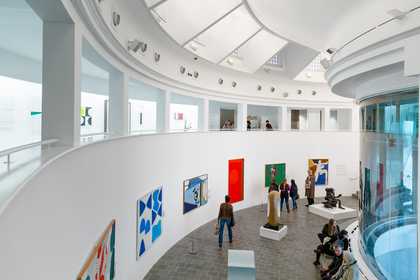Glimpse the diverse range of influences on modern british painting from the 1960s onwards
It considers how some modern artists associated with St Ives were now established on an international scene and reassessed how their work related to a rapidly changing artistic and social climate both at home and abroad.
At the beginning of the decade, contact with leading abstract artists in New York, such as Mark Rothko and Willem de Kooning, offered new perspectives
for artists working here. For some, including Peter Lanyon, Barbara Hepworth and Bryan Wynter they shared an interest in elemental forces, spiritualism
and the rhythms of natural phenomena.
For others, such as Roger Hilton and Patrick Heron, the focus of younger American painters on their choice of materials and processes created heated debate about the need for subject and meaning. At this moment Hilton defiantly produced large-scale, erotically charged depictions of female figures. Heron’s colourful abstract canvases grew to an immersive scale before becoming more figurative in the 1980s.
In parallel with other international centres, by the mid-1960s the British art scene was open to a broad range of approaches and ideas. Driven by mass media and counter-culture, younger British artists were responding to social and economic change, migration and civil rights, class, sexuality, women’s rights and consumerism. ‘Pop artists’ in London reintroduced colour, used found or industrial materials and processes, and combined abstract and figurative styles. William Scott, Peter Lanyon and Bryan Wynter notably made a shift to flatter, more graphic styles. Later Lanyon also included found elements in his paintings as a form of collage. Wynter experimented with psychedelic mobiles and used his experiments into the optical effects of flowing water in his late paintings.
Other artists working in West Cornwall such as British artist Patrick Hayman and German émigré Karl Weschke explored traditional myths and legends in a semi-abstract style that reaffirmed their cultural identity and personal experience.
Tate St Ives

